Jira vs Clickup: Feature-by-Feature Battle for Modern Teams
Jira or ClickUp? Discover how these project management tools stack up on features, pricing, and usability — plus insights for modern teams.
When teams search for the best project management software, two tools often rise to the top: Jira and ClickUp. Both are powerful and popular, but they serve very different types of teams.
Jira is known for its strong Agile and software development features, while ClickUp aims to be a flexible all-in-one workspace for any kind of team. That leaves many managers asking the same question: Jira vs ClickUp — which one is the better choice for modern teams in 2025?
In this guide, we’ll compare the two tools feature by feature — from task management and reporting to pricing and ease of use. Whether you’re leading a dev-heavy team or a cross-functional group, this breakdown will help you decide which platform best fits your workflow.
Snapshot of Jira and ClickUp
When it comes to project management, Jira and ClickUp are two heavyweights that dominate the field, each bringing a unique flavor to the table. Here’s a quick look at their origins, capabilities, and ideal use cases:
Jira Overview
Jira was developed by Atlassian and originally built as a bug and issue tracking tool. Over the years, it has evolved into one of the most widely used platforms for Agile Project Management. Jira is known for its robust support of Scrum and Kanban, detailed backlog management, sprint planning, and advanced reporting. It also connects with the wider Atlassian ecosystem, including Confluence, Bitbucket, and Trello.
Best suited for: Software development, IT, and product teams that work in Agile environments and need powerful issue tracking and reporting.
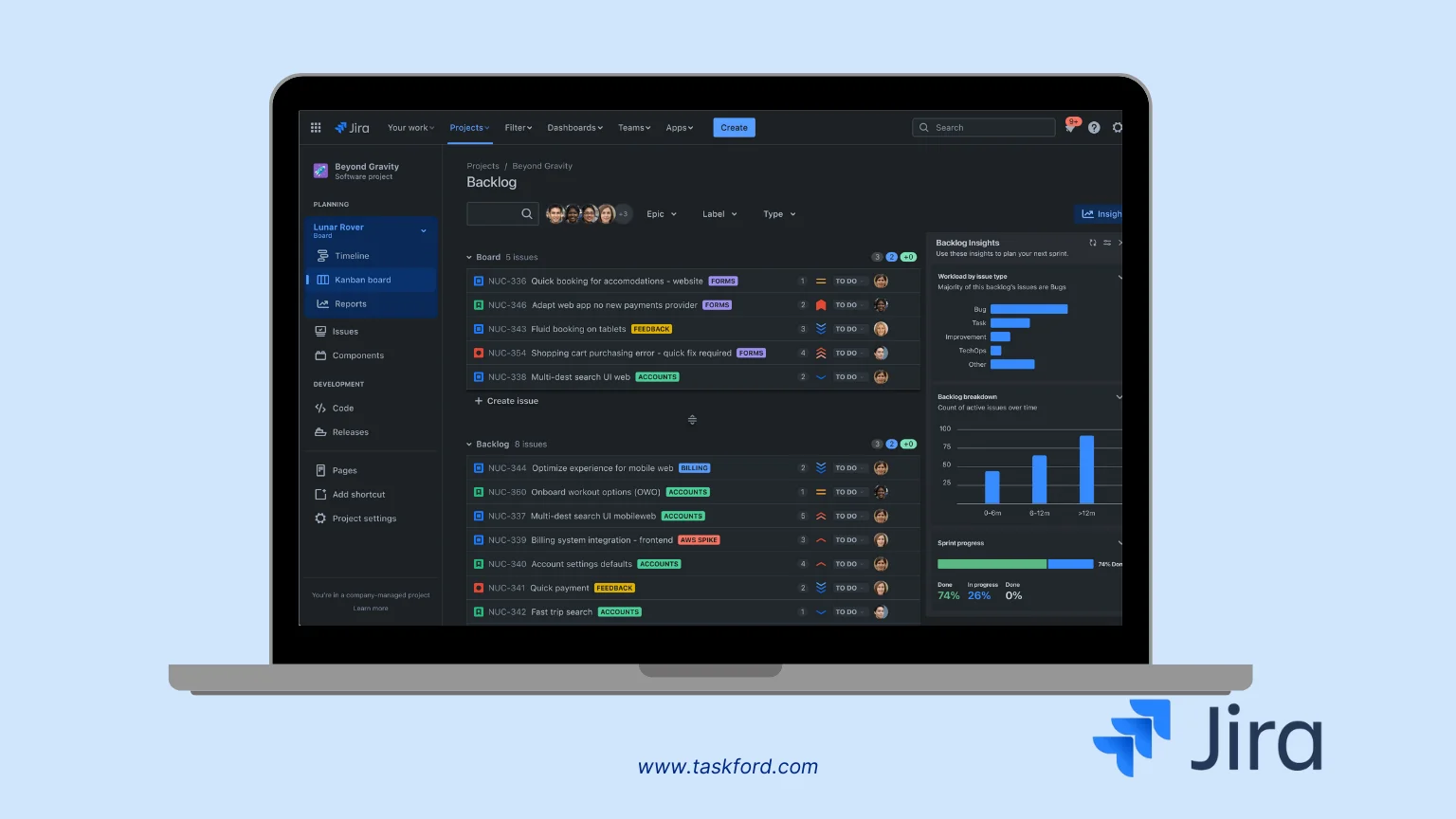
ClickUp Overview
ClickUp entered the market as a modern, all-in-one productivity platform, aiming to replace multiple tools with a single workspace. Its biggest strength is flexibility — offering features such as task management, docs, chat, goals, dashboards, time tracking, and whiteboards, all highly customizable to match different workflows.
Best suited for: Cross-functional teams, startups, marketing, operations, and organizations that need a flexible all-in-one platformto manage tasks, documents, collaboration, and reporting in one place.
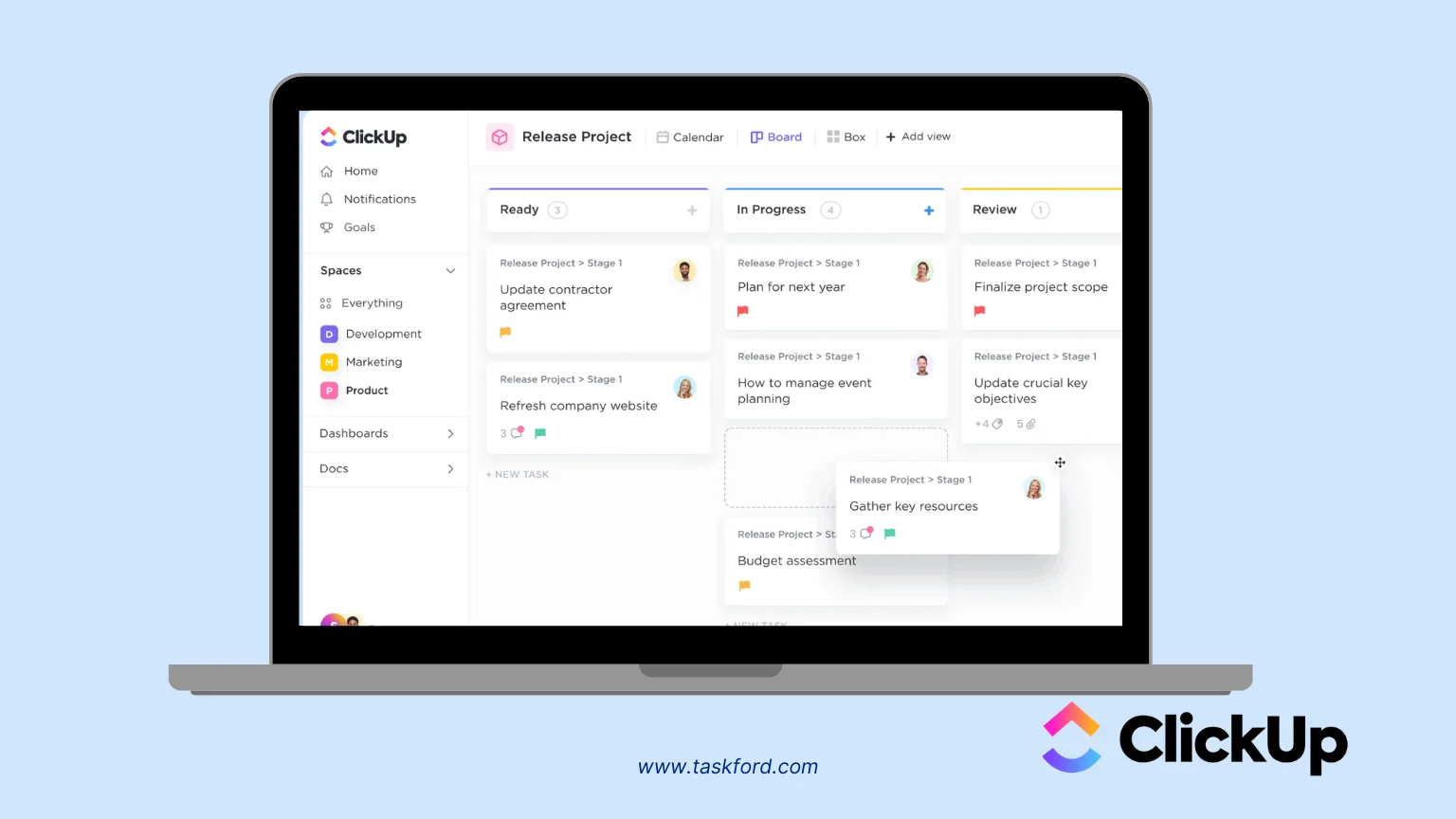
Feature-by-Feature Comparison
With both tools established as leaders, the real question is how they stack up in practice. Let’s break down Jira and ClickUp across the features that matter most to modern teams — from task management and Agile support to collaboration, reporting, and pricing.
1. Task Management
- Jira organizes tasks through an issue-based system, structuring work into epics, stories, and bugs with predefined workflows, making it ideal for software development but potentially rigid for non-technical teams.
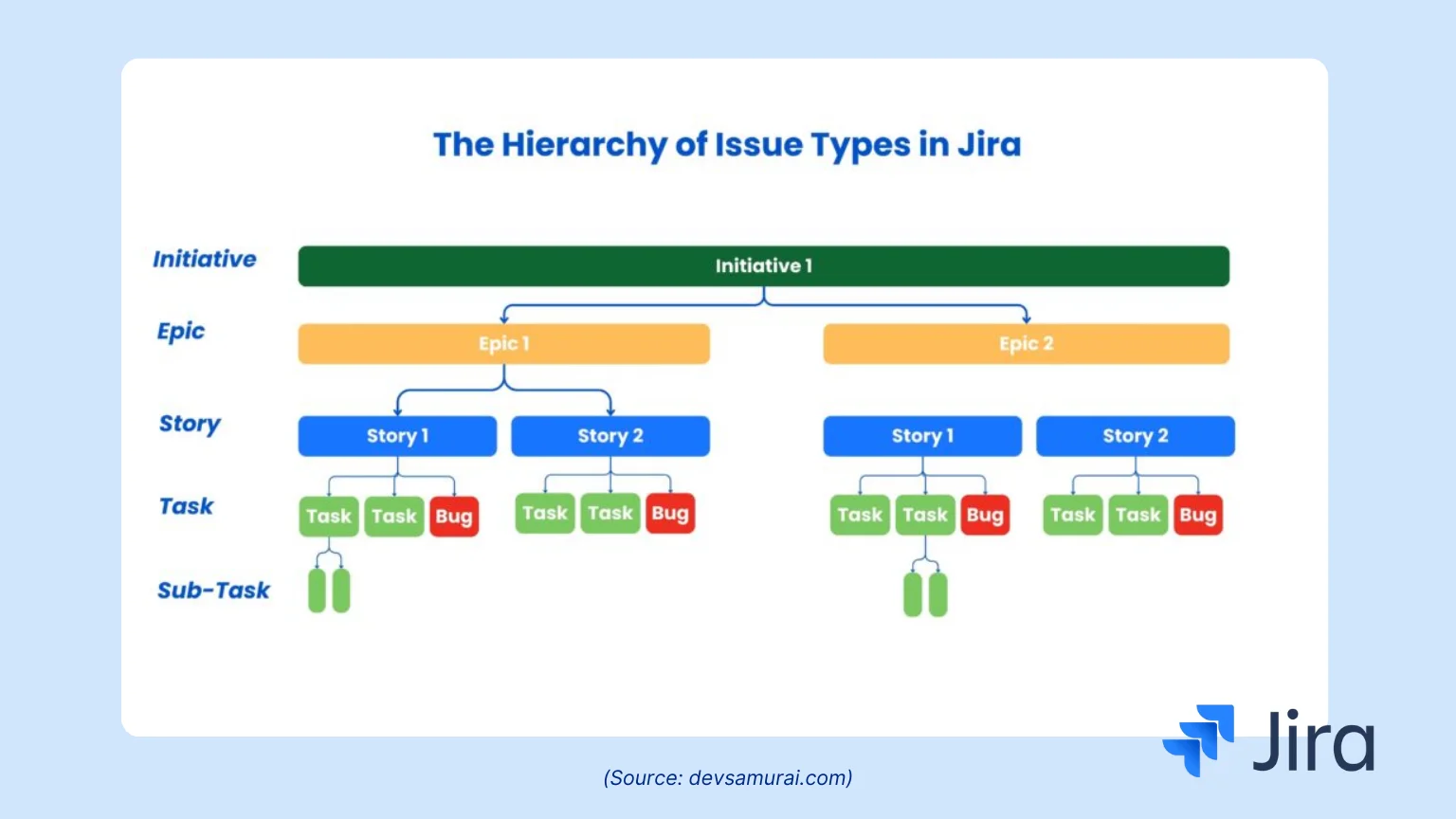
- In contrast, ClickUp offers a flexible six-level hierarchy, from Workspace to Subtasks, allowing teams to tailor task organization to diverse project needs with custom fields and statuses, though its feature-rich setup might overwhelm simpler workflows.
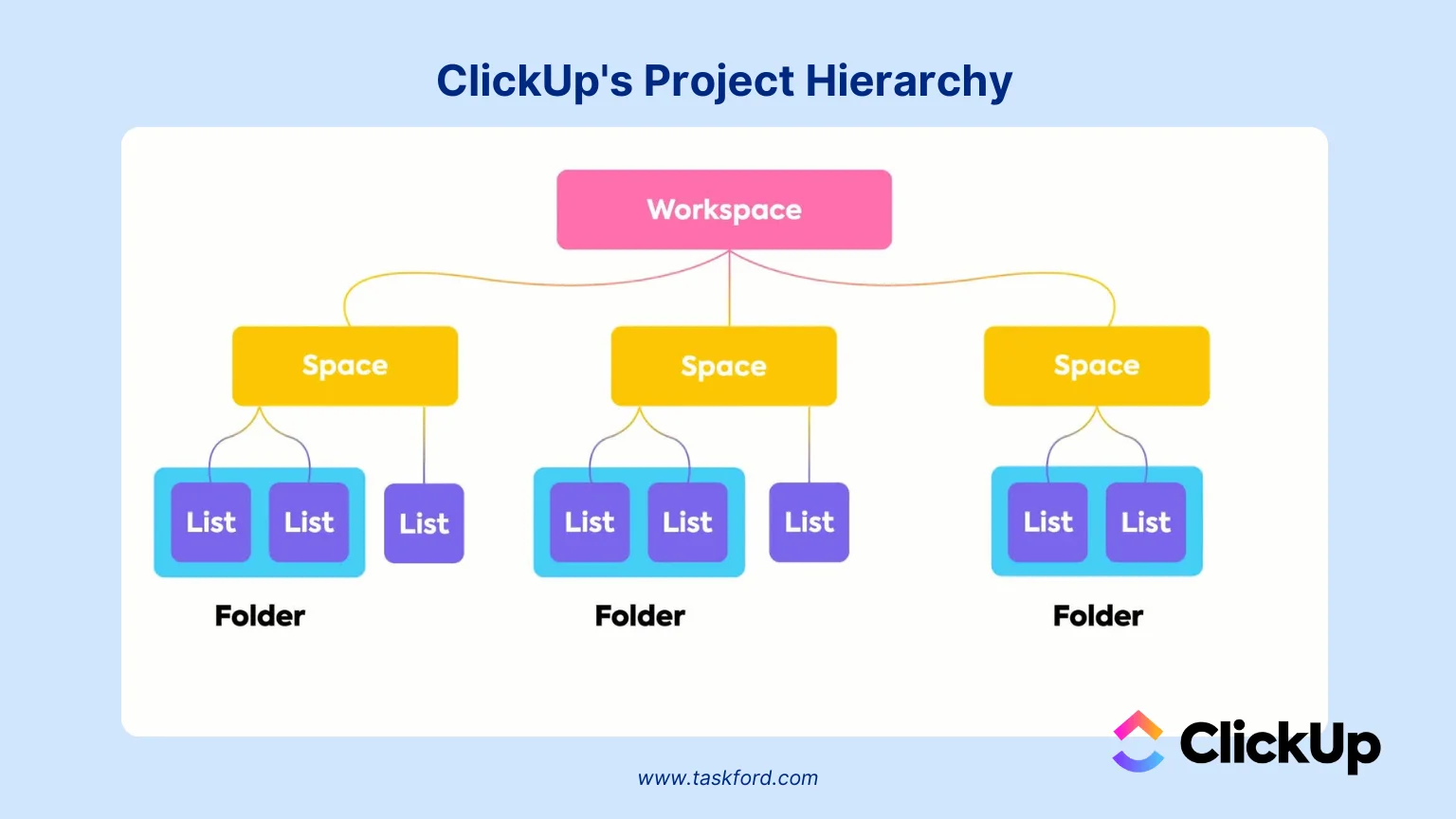
→ Key difference: Jira delivers a structured, technical approach best for development teams, while ClickUp provides an adaptable system suited for a wide range of industries and workflows.
2. Agile Methodologies
- Jira was built with Agile in mind, offering robust support for Scrum, Kanban, sprint planning, and backlog management. Its built-in reports make it a go-to choice for teams practicing Agile at scale.
- ClickUp supports Agile practices through boards, sprints, and custom workflows, but it is less specialized. It works well for teams blending Agile with other methods.
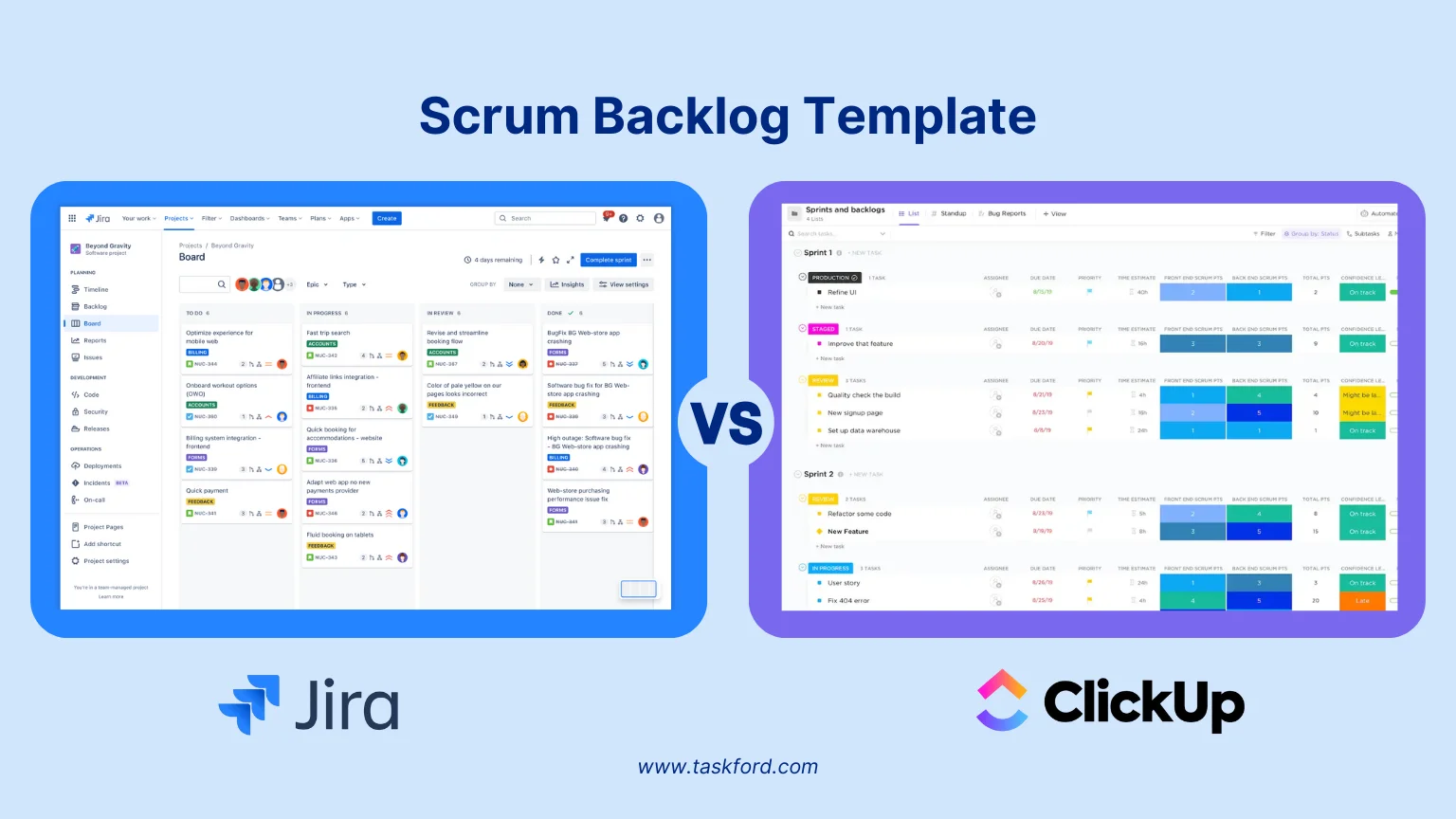
→ Key difference: Jira is purpose-built for Agile teams, while ClickUp offers Agile as part of a broader, more flexible toolkit.
3. Collaboration & Communication
- Jira provides collaboration features such as comments, mentions, and integrations with Confluence for documentation. While effective, it often relies on the Atlassian ecosystem for deeper collaboration.
- ClickUp integrates collaboration into its core with docs, whiteboards, real-time chat, and goal tracking, allowing teams to plan, discuss, and execute in the same space.
→ Key difference: Jira depends on integrations for collaboration, whereas ClickUp delivers an all-in-one experience.
4. Time Tracking
- Jira includes only basic time tracking and often requires third-party plugins like TeamBoard TimePlanner for detailed time tracking and reporting.
![]()
- ClickUp provides built-in time tracking with the ability to log hours, set estimates, and integrate with external time management tools.
![]()
→ Key difference: Jira requires add-ons for robust time tracking, while ClickUp includes it natively.
5. Reporting & Analytics
- Jira excels in reporting with Agile-specific tools like sprint velocity charts,burndown charts, and release tracking, providing detailed insights for technical teams but often requiring configuration for broader use.
- ClickUp delivers customizable dashboards and reports that cater to diverse project needs, offering user-friendly visualizations without deep technical expertise.
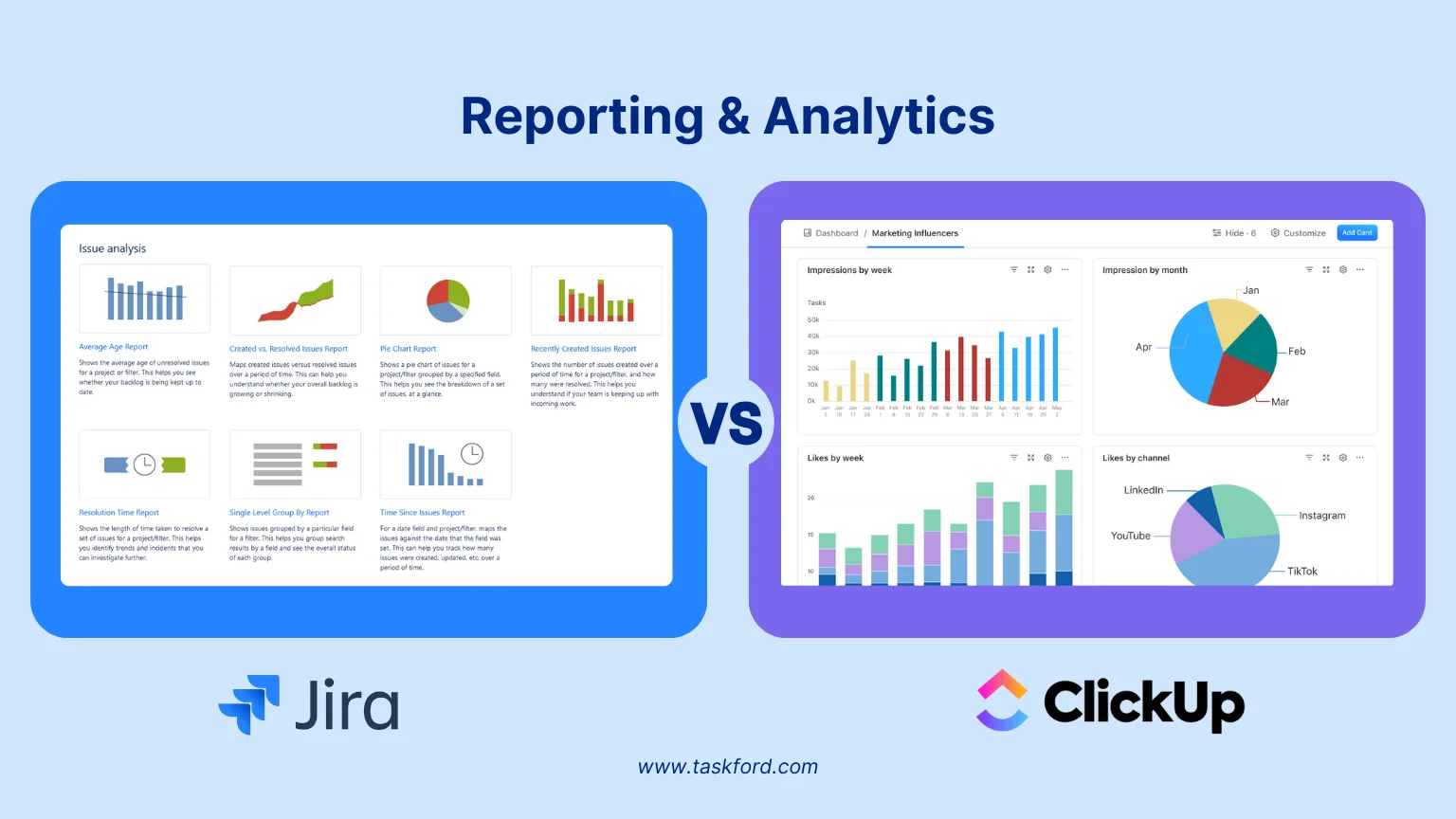
→ Key difference: Jira is stronger for Agile-specific reporting, while ClickUp offers broader, customizable insights.
6. Integrations
- Jira boasts over 3,000 integrations through the Atlassian Marketplace, connecting seamlessly with developer tools like Bitbucket and Confluence, ideal for technical teams but potentially overwhelming for simpler setups.
- ClickUp integrates widely with productivity, communication, and business tools such as Slack, Google Drive, and HubSpot, offering more variety outside development.
→ Key difference: Jira is best for Atlassian-based teams; ClickUp offers wider integrations for cross-functional use.
7. Customization
- Jira allows highly detailed customization of workflows, fields, and permissions, making it a powerful option for technical teams that need precision. However, this flexibility comes with complexity, often requiring admin expertise to set up and maintain.
- ClickUp emphasizes easy-to-use customization, offering drag-and-drop fields, custom statuses, and templates that non-technical users can adjust quickly. It balances flexibility with accessibility, but may not reach the depth Jira offers for complex workflows.
→ Key Difference: Jira offers advanced customization for technical teams, while ClickUp makes customization easier and more approachable for all users.
8. User Interface & Ease of Use
- Jira provides a feature-rich interface designed to handle complex project structures. While powerful, the learning curve can be steep, and new users may find it overwhelming without training.
- ClickUp has a modern and intuitive interface, designed for quick onboarding and ease of navigation. That said, the abundance of features can sometimes feel cluttered, requiring teams to streamline their setup.
→ Key Difference: Jira rewards experienced teams with its depth, while ClickUp is more beginner-friendly and faster to adopt.
9. Pricing
- Jira provides a free plan for up to 10 users, with paid plans starting at $8.60 per user per month, offering scalability but higher costs for larger teams.
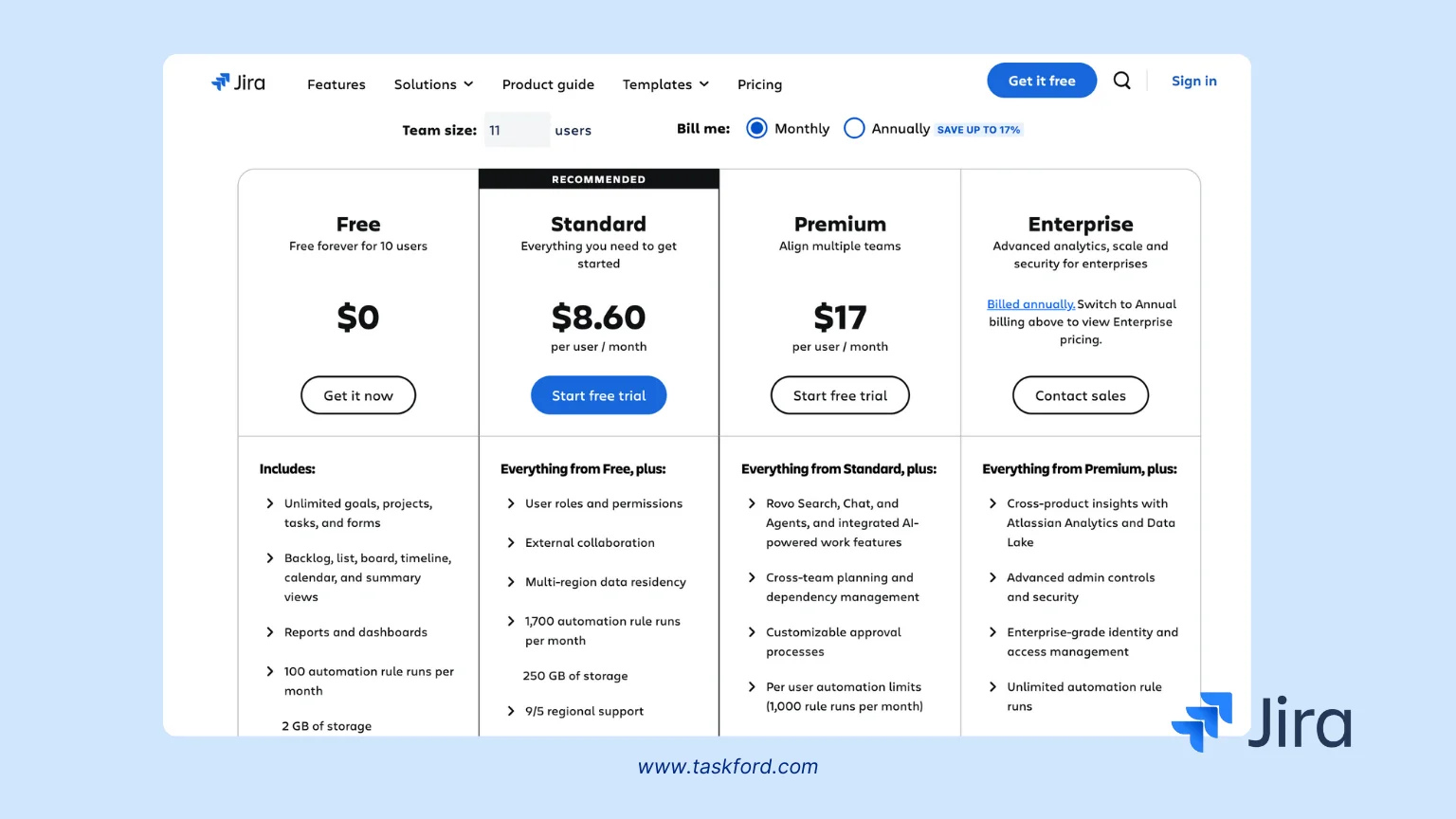
- ClickUp’s free plan includes unlimited users with robust features, and paid plans start at $10 per user per month, making it more budget-friendly.
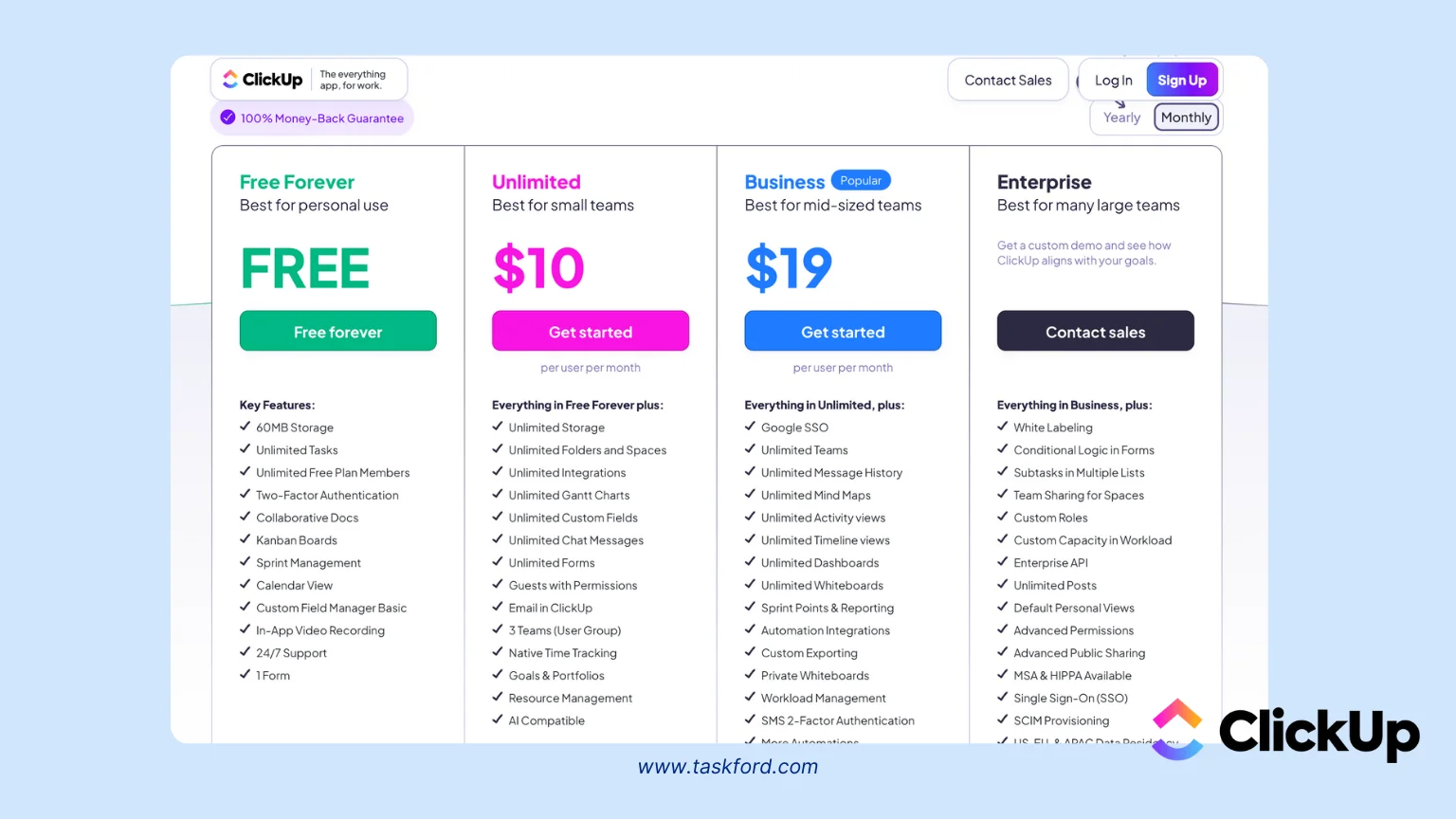
→ Key Difference: Jira’s pricing model favors large enterprises, while ClickUp delivers better value for smaller and growing teams.
Jira vs ClickUp: Pros and Cons
No tool is perfect. Both Jira and ClickUp bring impressive strengths but also come with trade-offs that teams need to consider before committing.
✅ Jira Pros
- Purpose-built for Agile with strong Scrum and Kanban support.
- Advanced reporting and analytics tailored to development teams.
- Deep integration with Atlassian’s ecosystem (Confluence, Bitbucket, Trello).
- Highly customizable workflows and permissions.
- Scales well for enterprise-level organizations.
❌ Jira Cons
- Steep learning curve for new or non-technical users.
- Setup and customization can be complex and time-consuming.
- Collaboration features rely heavily on integrations (e.g., Confluence).
- Pricing can become high as teams scale and add features.
✅ ClickUp Pros
- Flexible all-in-one platform suitable for diverse industries.
- Built-in collaboration features like docs, chat, and whiteboards.
- Intuitive and modern user interface with easy onboarding.
- Strong customization that doesn’t require technical expertise.
❌ ClickUp Cons
- Feature-rich setup can feel overwhelming for smaller teams.
- Agile functionality is less specialized compared to Jira.
- Performance can slow down with large workspaces.
- Some advanced features require additional configuration.
- Pricing can become high as teams scale and add features.
Best Use Cases
While Jira and ClickUp share the same goal of helping teams manage projects, their strengths make them better suited for different scenarios.
When Jira Works Best
- Software Development & IT Teams → Ideal for teams practicing Agile methodologies with heavy reliance on Scrum, Kanban, and issue tracking.
- Enterprises with Complex Workflows → Suited for organizations that need advanced customization, reporting, and integration with developer tools.
- Agile-First Organizations → Perfect for companies that already follow structured Agile frameworks and want a platform built around them.
When ClickUp Works Best
- Cross-Functional Teams → Great for marketing, sales, operations, and startups looking for one tool to manage varied workflows.
- Small to Mid-Sized Teams → Flexible pricing and an intuitive interface make it easier to adopt without steep learning curves.
- All-in-One Workspace Needs → Ideal for teams wanting built-in docs, chat, whiteboards, and dashboards without relying heavily on third-party tools.
Verdict: Which Tool Wins for Modern Teams?
When it comes to Jira vs ClickUp, there’s no single winner — it all depends on your team’s priorities.
- Jira shines for software development and IT teams that rely on structured Agile practices. Its depth in issue tracking, sprint planning, and Agile reporting makes it the go-to for teams who need precision and are willing to manage the complexity.
- ClickUp, on the other hand, is better suited for cross-functional and growing teams that want flexibility and an all-in-one workspace. With its built-in collaboration tools, customizable workflows, and budget-friendly pricing, it’s a strong choice for organizations outside the strict Agile mold.
Looking for a Simpler & Modern Alternative? Meet TaskFord!
If Jira feels too complex and ClickUp too overwhelming, there’s good news: modern teams now have simpler, balanced options. One of them is TaskFord — a comprehensive project and resource management platform designed to combine power with usability.
What is TaskFord?
TaskFord is an advanced project management and resource planning platform built to scale with teams of all sizes — from small startups to large enterprises. It offers a comprehensive suite of features that help businesses plan, manage, and execute projects efficiently, while also optimizing resource utilization and budget tracking.
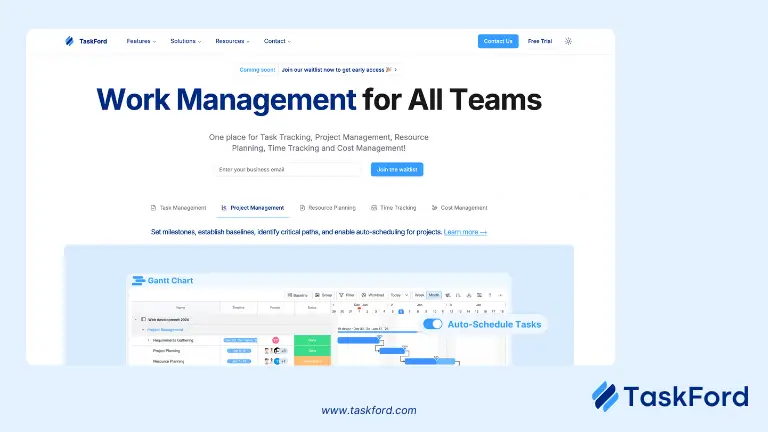
Whether you’re managing a single project or overseeing an entire portfolio of initiatives, TaskFord streamlines complex workflows into a clean, user-friendly experience, ensuring projects stay on track and teams remain aligned.
Key Features of TaskFord include:
- Dynamic Gantt Charts: Easily map out project timelines, milestones, task dependencies, and critical paths to track progress and keep every phase of your project on schedule.
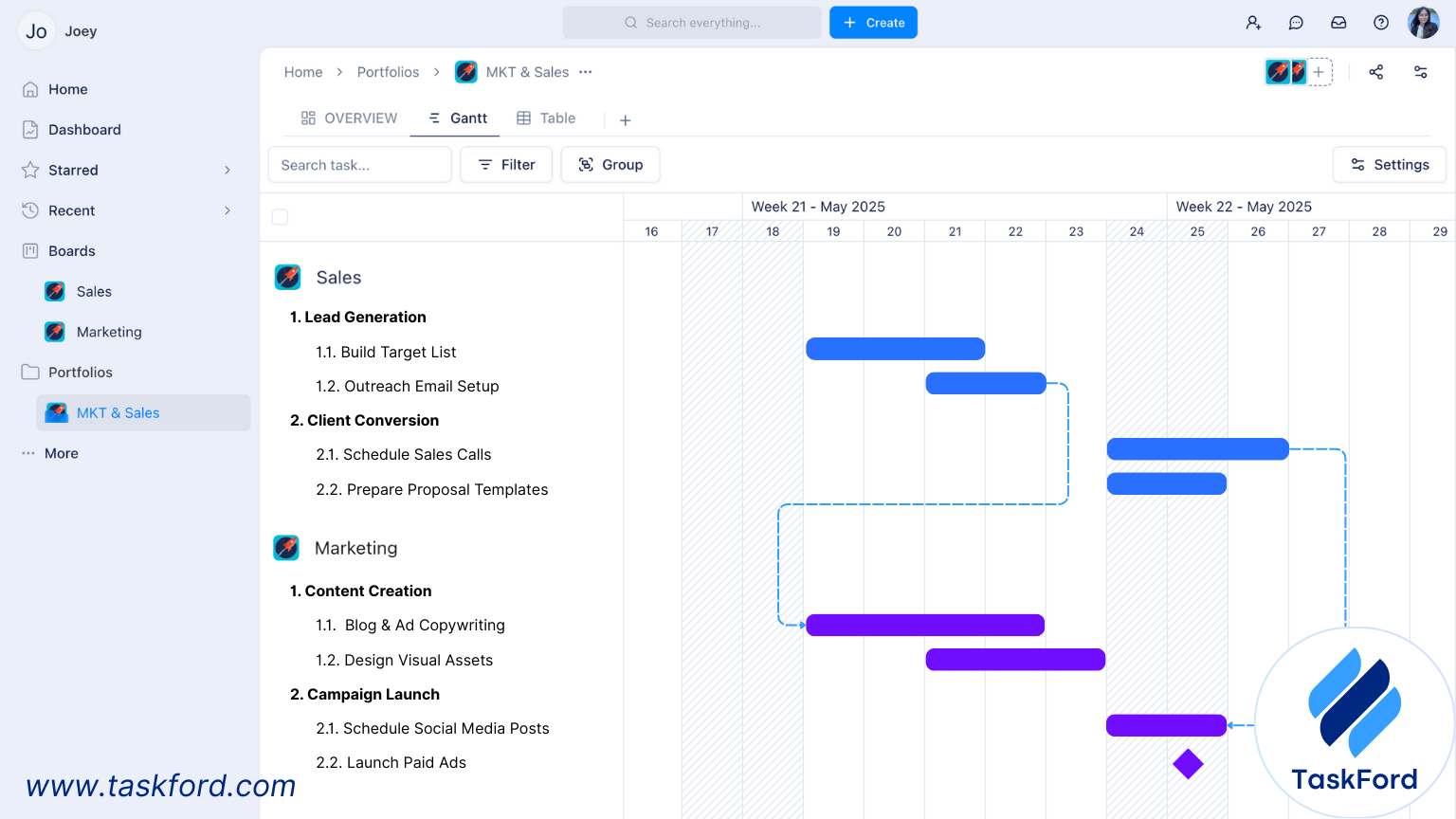
- Kanban, Table, Schedule & Calendar Views: Customize your workflow with flexible views to manage tasks in the way that best suits your team’s needs, whether it’s visualizing progress or tracking deadlines.
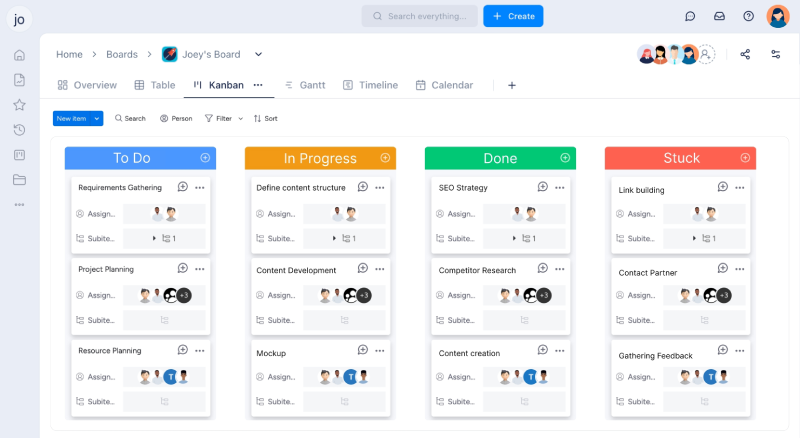
- Workload & Resource Tracking: Efficiently monitor team capacity, balance workloads, and plan leave or vacations to ensure optimal resource allocation and prevent overburdening.
- Portfolio & Budget Management: TaskFord helps track multiple projects simultaneously, align resources with business priorities, and stay on top of costs to maintain financial control and project alignment.
- Built-In Reporting & Analytics: Access real-time insights into project progress, team performance, and resource utilization, empowering informed decision-making and continuous improvement.
Why Choose TaskFord Instead?
TaskFord bridges the gap between overly complex and overly cluttered tools, giving teams a simpler, balanced way to manage work. Here’s why modern teams choose TaskFord:
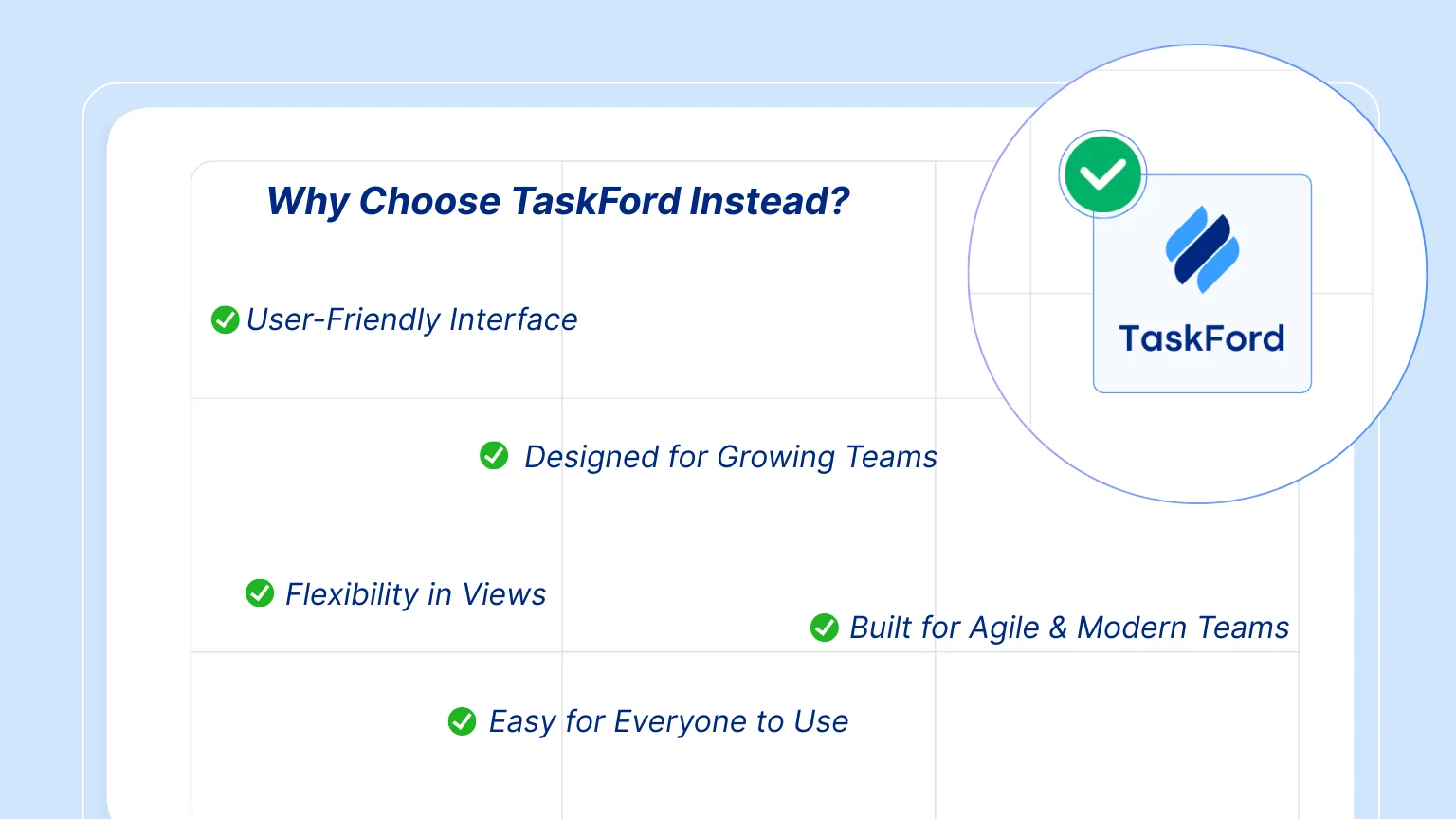
- User-Friendly Interface TaskFord’s clean, intuitive design ensures that teams can get up and running quickly — without the need for complex training or lengthy onboarding processes.
- Flexibility in Views Whether you prefer Gantt charts, Kanban boards, tables, or schedules, TaskFord adapts to your team’s preferred workflow, making it easy to visualize and manage tasks the way you work best.
- Designed for Growing Teams TaskFord scales with your business, from managing small projects to handling large portfolios, ensuring that your team stays aligned and efficient as your organization expands.
- Built for Agile & Modern Teams Supporting Agile methodologies, TaskFord is flexible enough to accommodate cross-functional teams, whether you’re working in sprints, tracking milestones, or adapting to evolving project needs.
- Easy for Everyone to Use TaskFord’s straightforward design makes project management accessible to both technical and non-technical users, ensuring all team members can collaborate effectively, regardless of their expertise.
How is it Different?
TaskFord stands apart by combining the power of advanced project management with the simplicity teams actually need. Unlike Jira, it doesn’t require heavy setup or technical expertise, and unlike ClickUp, it avoids overwhelming users with unnecessary complexity.
Here’s what makes TaskFord different:
- Built-In Resource Management → Track team capacity, workloads, leave, and vacation planning without relying on third-party add-ons.
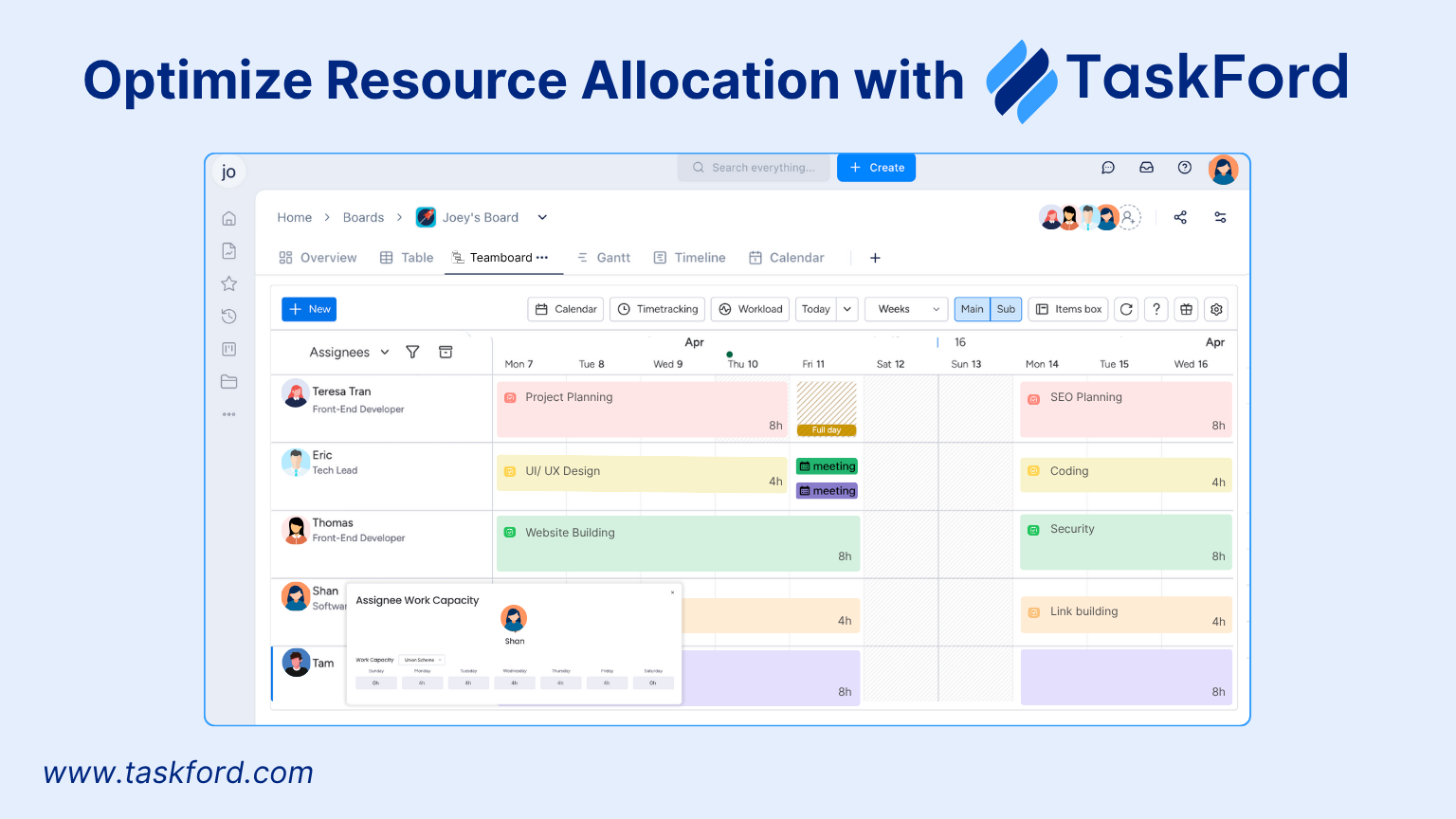
- Budget & Cost Tracking → Keep an eye on project budgets and expenses alongside task progress.
- Portfolio Management Made Simple → Manage multiple projects in one place with clear visibility into milestones and dependencies.
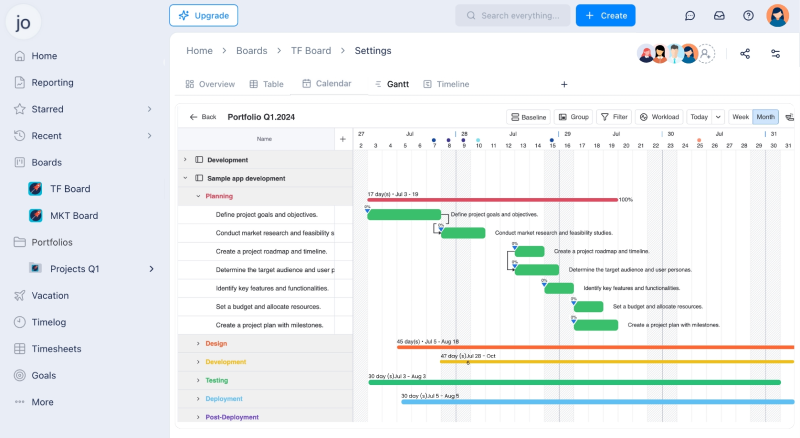
- Balanced by Design → Powerful enough for enterprises, yet streamlined so smaller teams don’t get lost in features they’ll never use.
Explore more about the top reasons why teams look for ClickUp Alternatives and a detailed TaskFord vs ClickUp comparison.
In short, TaskFord provides the right balance of structure and flexibility, helping modern teams stay productive without the friction of over-complicated tools.
Conclusion
Both Jira and ClickUp are excellent tools, but each suits different needs. Jira is strongest for structured Agile teams, while ClickUp works better for cross-functional groups looking for versatility. If neither feels like the right fit, modern alternatives such as TaskFord provide other options worth exploring. In the end, the right tool is the one that helps your team stay aligned and deliver results.
Related Articles:
- ClickUp Project Management vs Alternatives in 2025: Which Tool Fits Your Team
- Microsoft Project vs Monday for Project Management - A Full Review & Comparison
- Asana vs Smartsheet: Which Project Management Tool Fits Your Team?
- Wrike vs Monday: Which Project Management Tool Should You Choose For Your Team?
Subscribe for Expert Tips
Unlock expert insights and stay ahead with TaskFord. Sign up now to receive valuable tips, strategies, and updates directly in your inbox.